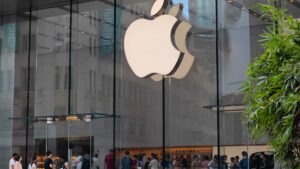How Rising Tariffs Affect Apple: What Investors Need to Know
In the world of investing, staying informed about market dynamics is crucial, especially when it involves major players like Apple Inc. Recently, Apple shares experienced a noticeable dip as geopolitical tensions rose, particularly in relation to tariffs imposed by the U.S. government on Chinese imports. If you’re an investor keen on understanding how these developments may impact your portfolio, you’re in the right place.
A Quick Recap: Recent Developments
On Thursday, Apple’s stock fell nearly 5% following President Donald Trump’s announcement of new tariff escalations against China. This reversal came after a significant increase of over 15% in the previous trading session, driven by a temporary easing of tariffs to 10% for imports from most countries. However, the primary concern for investors remains the steep rise in tariffs on Chinese imports, which has reached a staggering 145%.
Apple’s reliance on China as a manufacturing hub means that the company could face serious operational challenges if these tariffs persist. Analysts are beginning to speculate on how Apple might adjust its pricing strategy in response to these external pressures.
Price Hikes: Inevitable or Avoidable?
Analyst Cherry Ma from Macquarie Equity Research believes that price increases are almost unavoidable. She suggests that a global price hike for the upcoming iPhone 17 series could range from 13% to 21%, with even steeper increases projected for products like the Mac (32% to 43%) and iPad (21% to 28%). Ma argues that the tariffs could force Apple to reevaluate its pricing strategy to maintain its profit margins, especially as newer models with advanced features are on the horizon.
Interestingly, Apple’s supply chain is not expected to shift back to the U.S. any time soon, primarily due to underdeveloped logistics in other regions, despite some options providing lower import tariffs than China and Vietnam. This leaves Asia firmly entrenched as Apple’s production hub for the foreseeable future.
A Counterpoint: Morgan Stanley’s Perspective
In contrast, Morgan Stanley analyst Erik Woodring presents a different view. He argues that Apple might be able to sidestep significant price hikes through strategic adjustments in production and product mix. Increasing production in India and focusing on higher-margin iPhone models could help mitigate the impact of tariffs. Woodring believes that if Apple efficiently shifts consumer demand toward premium models, the average selling price of the iPhones might rise without altering the retail prices of individual models.
This nuanced perspective highlights the inherent complexity in forecasting Apple’s responses to external pressures. Investors should weigh these differing views as they consider their investment strategies.
The Bigger Picture: An Investor’s Consideration
Apple’s recent stock fluctuations are part of a larger narrative impacting the tech industry. As an investor, it’s vital to not only analyze the influence of tariffs but also to consider broader market conditions, the competitive landscape, and Apple’s long-term growth strategies.
With shares down nearly 24% year-to-date, the question remains: Is now the time to buy the dip, or should investors wait for more clarity? Here at Extreme Investor Network, we advocate for a well-rounded investment approach that includes staying updated on macroeconomic indicators, company fundamentals, and industry trends.
Stay Informed and Engage
In times of uncertainty, knowledge is power. For more insights and in-depth analysis of such market shifts and how they could impact your investments, explore our archives, subscribe to our newsletter, or join our community. We believe informed investors are successful investors, and we’re dedicated to providing you with unique insights that keep you ahead of the curve.
Remember, in investing, staying ahead is not just about reacting to changes—it’s about understanding them deeply and making informed decisions. Let us help you navigate the complexities of investment in today’s ever-changing market landscape.

